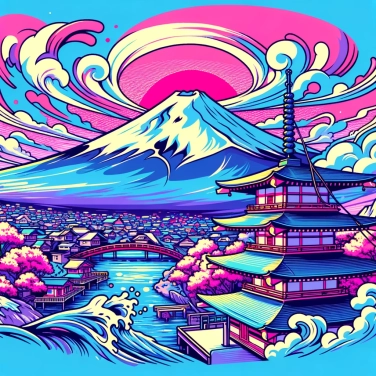Mount Fuji is considered sacred in Japan because of its cultural and spiritual importance in the Shinto religion. It is revered as a deity and symbol of purity for centuries.

For the Japanese, Mount Fuji is not just a beautiful mountain; it is a true deity called kami. In Shinto tradition, the goddess Konohanasakuya-hime, the deity of Fuji, is particularly venerated, associated with volcanoes and cherry blossoms. This sacred connection explains why, for centuries, Fuji has been seen as the protector of the country, a symbol of purity and a source of spiritual strength. This sacred relationship with Fuji has led to the construction of numerous Shinto shrines all around the mountain, dedicated to honoring its spirit and seeking its blessings. Even today, you can easily encounter Japanese people who have come to pray or thank Mount Fuji for its protection, a living testament to this sacred bond that remains strong in the hearts of the people.
Buddhism has played a significant role in the sanctification of Mount Fuji. As early as the Japanese Middle Ages, Buddhists associated the mountain with intense spiritual practices, particularly by representing it as a kind of earthly paradise or a physical expression of enlightenment. Fuji quickly became a place where monks and practitioners would isolate themselves to meditate in an exceptional setting in search of spiritual awakening. Thanks to Buddhism, the mountain is also seen as the residence of an important deity, notably the cosmic Buddha Dainichi Nyorai. This kind of spiritual association has further reinforced its sacred aspect.
For centuries, Mount Fuji has attracted thousands of pilgrims who come to climb its slopes to get closer to the sacred and to spiritually purify themselves. The traditional route, known as Yoshida, is the most popular to reach the summit. As they ascend, the pilgrims stop at small shrines and refuges called stations, each with a specific spiritual significance. Throughout this ascent, the walkers engage in simple rites such as reciting prayers, making offerings to the deities, and performing meditation exercises. Even today, many choose to climb at night to admire the sunrise from the summit, a powerful moment symbolizing spiritual rebirth. The Fuji hike is undertaken as much to connect with oneself and nature as to honor the mountain deities.
Mount Fuji holds a prominent place in several Japanese popular myths. One of the most well-known legends tells the story of the goddess Konohanasakuya-hime. She is the deity of volcanoes and is said to have pacified the anger of the volcano by seeking refuge within it, which would explain why the eruptions calmed down. Another famous legend recounts the story of the bamboo cutter named Taketori Monogatari, or "The Tale of the Bamboo Cutter." He discovers a mysterious girl named Kaguya-hime, a princess from the Moon. At the end of the story, when the princess returns to her people, she leaves behind an elixir of immortality that will be burned at the summit of Mount Fuji. These tales combine the spiritual and magical aspects of the volcano, making it a place rich in symbolism and often associated with supernatural forces.
Mount Fuji has always fascinated with its perfectly symmetrical shape and snow-capped peak, considered the ideal representation of pure beauty. The Japanese see in this natural harmony something akin to divine perfection, a place where the boundaries between earthly beauty and spirituality easily blur. This mountain embodies the idea of the sublime, an exceptional landscape that commands respect and admiration, naturally encouraging reflection and spiritual contemplation. Mount Fuji thus becomes a visual and emotional bridge between humans and the sacred, where its aesthetic magnificence directly nourishes its religious character.
In 2013, Mount Fuji was designated a UNESCO World Heritage site due to its outstanding cultural value. This recognition pertains not only to the mountain itself but also to 25 surrounding sites, including Shinto shrines and historic inns for pilgrims.
Traditionally, the first ascent of the year at sunrise, known as 'Goraiko,' is considered particularly lucky, bringing health and happiness according to Japanese belief.
Mount Fuji frequently appears in traditional Japanese art. It is particularly at the heart of the work "Thirty-Six Views of Mount Fuji," a famous series of prints by the master Hokusai dating from the 19th century.
Every year, around 300,000 people undertake the ascent of Mount Fuji during the short summer period (July-August), when access to the summit is officially permitted and safe.
According to Shintoism, Mount Fuji is regarded as the abode of deities known as kami, particularly Konohanasakuya-hime, the goddess of flowers, fertility, and protection against fire. This divine presence strongly contributes to the sacred dimension of the mountain.
The last eruption of Mount Fuji dates back to the year 1707, during the Edo period. This eruption, known as the Hoei eruption, permanently altered the surrounding landscape and deepened the spiritual reverence for the natural power embodied by this mountain.
Mount Fuji, as a cultural and spiritual icon of Japan, has inspired many artists, including Hokusai and Hiroshige. Its perfect, harmonious shape and spiritual dimension make it a particularly cherished motif, symbolizing both the natural beauty and the sacred aspect of the Japanese landscape.
Yes, pilgrimages continue today. Every year, many Japanese people and visitors from around the world ascend its slopes as a ritual pilgrimage, with the intention of spiritual purification, meditation, or simply in search of personal and spiritual fulfillment.
No. The official ascent of Mount Fuji is only open during the summer, typically from early July to early September. During this period, the facilities are operational, and the weather conditions are favorable. Outside of this season, climbing is strongly discouraged due to dangerous weather conditions and the lack of assistance.

No one has answered this quiz yet, be the first!' :-)
Question 1/6